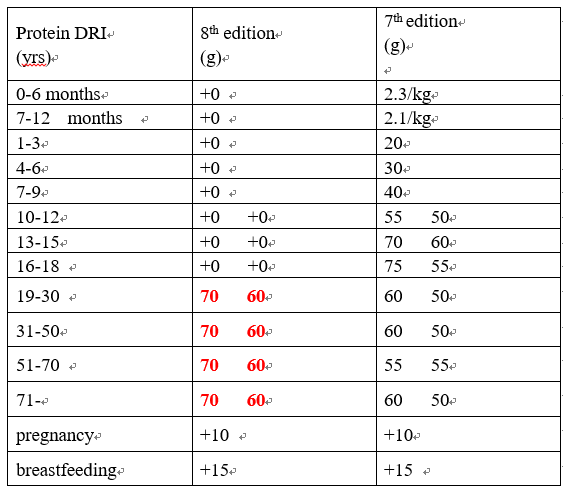" Dietary Reference Intakes" Eighth Edition-Macronutrients Protein and lipid chapter (draft) revision
Highlights of the online seminar
1. The updated and revised chapters includes Macronutrients: Protein and Lipids.
2. Updated chapter includes:
(1) The chapter of Protein:
i. A new method for evaluating protein needs, indicator amino acid oxidation method (indicator amino acid
oxidation technique, IAAO).
ii. New protein quality evaluation method Digestible Indispensable Amino Acid Score (DIAAS) description.
iii. A total of 28 articles related to protein reference intake have been updated and newly added. Mainly supplement the related literature for the elderly.
iv. With reference to the average protein requirement data estimated by the latest IAAO method, the revised recommended protein amount is 1.1 g/kg for adults over 70 and 1.2 g/kg for seniors over 80. The purpose of increasing the recommended amount of protein for the elderly is to prevent the occurrence of frailty and sarcopenia. To calculate the daily protein intake according to the reference weight, and take the integer 5 or 10. The result is 70 g/day for men of all ages and 60 g/day for women. The protein requirements of the first, second and third stages of pregnancy are obviously different, but in order to avoid practical application inconvenience, this version will not be divided into stages during pregnancy. It is recommended to take 10 g more daily, and daily intake of 15 g high-quality protein is recommended during breastfeeding period.
v. In terms of protein requirements for children and adolescents, the recommended intake for 10-12 years old is 1.4 g/kg (55 g/day) day for men and 1.3 g/kg (50 g/day) for women. 13 -15 years old is 1.3g/kg (70 g/day) for men and 1.2 g/kg (60 g/day) for women. 16-18 years old is 1.2g/kg (75 g/day) for men and 1.1 g/kg
(55 /day) for women.
vi. In the part of chronic disease risk relevance, in the systematic literature discussion on cancer, cardiovascular disease, obesity, osteoporosis, kidney disease, and sarcopenia, the relationship between protein and chronic disease still needs further research to clarify, but most literature does not show that a slightly higher protein is harmful to the general health public, and most have moderate evidence of benefits. In addition, soy or vegetable protein seems to help reduce the risk of most chronic diseases. In summary, the recommended requirements of protein intake for Chinese people tends to be slightly higher than the previous version.
vii. Protein recommended intake before and after difference comparison table:
(table.1)
(2) The chapter of Lipids:
i. According to the Nutrition and Health Survey in Taiwan (NAHSIT) in 2012, the rate of people suffering from metabolic syndrome and obesity-related diseases is more than 50% of middle-aged and elderly men and women, and the obesity rate is also more than 50%. It is referred to while amending our country’s recommended lipid intake.
ii. In accordance with the internationally established standards for lipid intake, in addition to the original essential fatty acid content, the importance of lipids in the overall diet is also presented in the text. Various fatty acids include saturated fatty acids, monounsaturated fatty acids, polyunsaturated fatty acids, etc. Biochemical function, physiological absorption and metabolism, factors that affect demand (such as: aging, drinking, physical activity, smoking and other factors that affect life style), and positive and negative effects on the human body, etc.
iii. Added 65 references and the new 21st century's new Acceptable Macronutrient Distribution Ranges (AMDR, Acceptable Macronutrient Distribution Ranges) concept description and the recommended intake range of total dietary fat, saturated fatty acids, n-6 fatty acids(linoleic acid), n-3 fatty acids(including linolenic acid, EPA, DHA), and trans fatty acids.
iv. This revision does not recommend setting the recommended amount of cholesterol. Although it is generally believed that reducing cholesterol intake as much as possible has a positive effect on health, the scientific evidence that can be used to calculate intake limits is not sufficient. At present, many countries do not set target intakes separately. It is only recommended to minimize high cholesterol foods.
v. Added the recommended intake of lipids:
(table.2)

